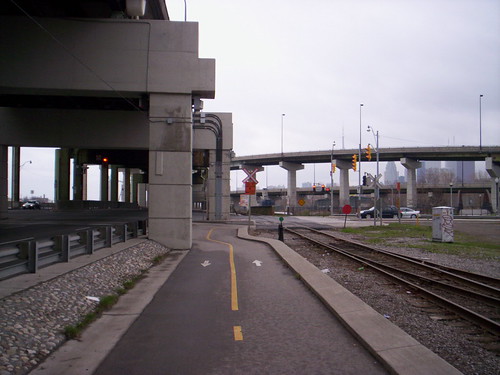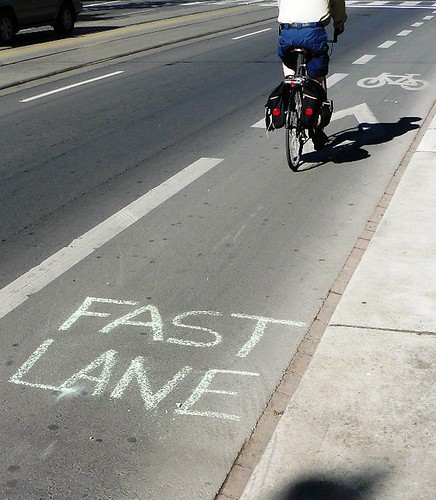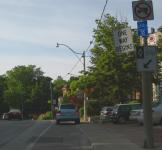Yesterday, Toronto Police Services issued this Press Release:
Safe Cycling: Share the Responsibility
Broadcast time: 10:05
Monday, June 18, 2007Traffic Services
416-808-1900Did you know that:
- one cyclist is injured every 9.21 hours on Toronto streets?
- the last seven cycling fatalities in Toronto have involved large commercial vehicles?
- each year about 1,100 cyclists are involved in collisions?
- riding your bicycle on the sidewalk endangers pedestrians?
- motorists parking in designated bike lanes endanger cyclists?
- motorists opening their doors without looking is hazardous to cyclists?
The Toronto Police Service will be initiating a one-week "Safe Cycling Share the
Responsibility" Campaign, starting Monday, June 18, 2007. The campaign will conclude on
Sunday, June 24, 2007. This will be the third initiative undertaken as part of the Service's
comprehensive traffic safety strategy, "Operation Safe Journey."The "Safe Cycling Share the Responsibility" Campaign will focus on motorists whose actions endanger the lives of cyclists. Drivers failing to proceed through turns safely, opening vehicle doors improperly, and driving in designated bicycle lanes, all contribute to reduced cycling safety.
For more information on "Safe Cycling Share the Responsibility", please contact Sergeant
Paul Bainard at 416-808-1908 or Constable Stephen Burns at 416-808-1919.Constable Isabelle Cotton, Public Information, for Constable Stephen Burns, Traffic Services
I find it interesting that there is clear emphasis on cracking down on motorists. Past safety blitzes I've heard about seem to always focus on cyclists. I wonder what the outcome of this will be? Will we hear a followup with some numbers? Will it be back to busines as usual next week with people parking all over the bike lanes, dooring cyclists, and passing too closely?
The Toronto Sun has an article in today's paper as well.
A lot of words and concepts have been thrown around in the interesting Lansdowne reconstruction debate that we've had here and here. I hope to clear up what I think are some of the misconceptions and misrepresentations.
 All modes of traffic are represented on this section of the waterfront, but guess which one gets priority?
All modes of traffic are represented on this section of the waterfront, but guess which one gets priority?
(Note: Another long post, because a seemingly simple thing as a single road reconstruction brings up lots of interrelated issues that are even here haphazardly dealt with.)
- First, let's be clear that traffic congestion is not something that is particularly relevant to Lansdowne. As the city staff have studied (pdf), the road is currently under capacity and it isn't anticipated that the reconstruction will put it over capacity, so any increased travel times for cars does not necessarily equate "traffic congestion". This isn't stop-and-go traffic.
- Let's be clear too that using the term "traffic" has come to mean solely motor vehicles to the exclusion of bikes, transit and pedestrians. Once we include transit, bikes and pedestrians in the model we could say that some traffic will be slower, but other traffic may be faster as their mode is improved. It's about reprioritizing transportation to favour higher value trips and lower cost modes.
- In the report Joe mentioned, the city staff did 24 counts on sections of Cosburn to measure changes in motor vehicle traffic volume on Cosburn and adjoining streets. They made the assumption that a "decrease in traffic volumes on Cosburn Avenue after implementation of the bike lanes would indicate that some traffic had diverted from Cosburn Avenue to alternate routes". Note that this isn't the same as talking about "disappearing traffic", where motor vehicle traffic would need to be tracked before and after construction to see what choices were made.
There is a relationship between travel time and traffic volume. Travel time is a measure of how long it takes for an individual car to make it across the study area. In the case of Cosburn, this is from Pape to Woodbine. Longer travel times suggests that some of the drivers will seek alternatives such as parallel streets. To measure the load on the road and parallel streets traffic volume is used. If traffic volume on the road in question decreases we likely see an increase on parallel streets, but if the we can't account for all shifted motor vehicle traffic then we can assume that some drivers chosen to take transit, bike, walk or avoid the inconvenience of the trip altogether.
Still, we should be careful in comparing the Cosburn to Lansdowne since on Cosburn they actually took out a travel lane whereas they aren't even doing that on Lansdowne. The difference may be even more minimal in terms of travel time, but it will be hard to tell since they are widening the travel lanes on the one hand, and putting in some pedestrian crossings that jut out.
- A few of the commenters have confessed their scepticism with the official studies, yet have provided only assertions and no proof on the traffic demand. In the absence of community-based studies of traffic dynamics and demand I propose we stick with the experts.
There has been the assumption that many of the motor vehicle trips on Lansdowne involve commuters to far-flung suburbs. I'd like to see such statistics if they are out there, but it doesn't cancel the effect of better cycling facilities helping shift travel modes from motor vehicles to bicycles. Studies suggest that there are a significant number of motor vehicle trips that involve distances easily covered by bicycle. A New York City study found that 22% of motor vehicle trips in NYC are under 1 mile and 56% are under 3 miles! (The original CityinFlux report can be found here (pdf)). There is a huge opportunity for making streets much friendlier for bikes and transit for these short distances. My own commute by bicycle is much longer so I think I can safely assume that there are a significant number of reasonably fit people that can tackle a 5 km bike ride during our 7-8 months of half-decent weather.
- These issues are nothing new. City traffic demand and dynamics have been studied for many years, if perhaps skewed towards encouraging motor vehicle traffic. Official plans over the years have tried various strategies for dealing with traffic, though mostly this has involved widening roads for motor vehicle traffic. Toronto's fairly progressive official plan takes positive steps in dealing with the increasing demand on the roads and created a strategy for increasing density along major corridors that need to be well-served by transit. Officials and experts haven't been taken by surprise by increasing traffic. We can't blame all the problems on current officials and politicians for a issue that has been set in motion since the dawn of the automobile. Critics have long known the problems with the over-reliance on automobiles -- Lewis Mumford is just one of many. There has, however, been a culture of complacency among the elite who were unwilling to upset the comfortable automobile class by making dramatic changes to the way we build and service our cities.
- I believe we need to have a carrot and stick strategy when it comes to shifting travel modes from private motor vehicles to transit, bikes, pedestrians and telecommuting. Driving needs to be discouraged and rewarding those choose alternatives. Real life doesn't work by saying we should just focus on education or study something to death before we do anything. It's all being done right now, we just need to do a lot more of it.
Lansdowne is an area well served by subway and buses. For the most part, the carrot is much more available there than many other distant parts of Toronto. Yet people still choose to drive because it is convenient. While transit needs to be made much more convenient and available, there has to be a point where we say that drivers should pay more for the unbalanced cost they impose on the rest of the population.
- ‹ previous
- Page 438
- next ›


